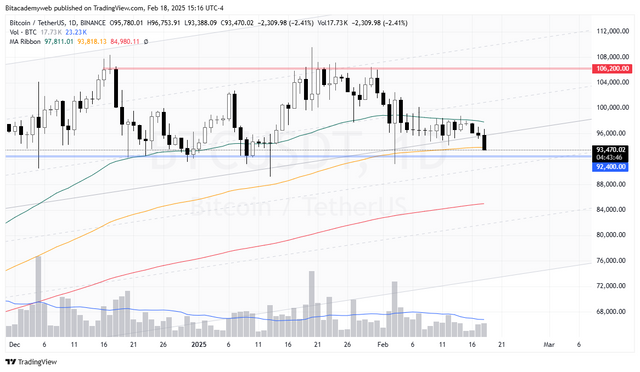Bitcoin under pressure from inflation and high FED rates
The leading cryptocurrency falls 2,41% in 24 hours as the dollar strengthens and investors adjust their expectations in the face of restrictive monetary policy.
Bitcoin fell 2.41% this Tuesday, trading at $93,470 at the time of this report, affected by the uncertainty surrounding the Federal Reserve's high interest rates (4.50%) and the rise in inflation. With a strong dollar and rising bond yields, the crypto market faces a complex scenario in the short term.

The current price of Bitcoin ($93,470) is below the EMA50 ($97,800), suggesting a bearish trend in the short term
Inflation and high rates: A dangerous cocktail for Bitcoin
The Federal Reserve maintains its interest rate in a range of 4.25%-4.50%, a restrictive policy that seeks to control inflation. This negatively impacts risk assets such as bitcoin. Given the high correlation of this cryptocurrency with the Russell 2000, investors consider it a risk asset. Mary Daly, president of the Federal Reserve Bank of San Francisco, reiterated that monetary policy must remain firm. At least until sustained progress is seen towards the 2% inflation target.
This scenario led futures market participants to delay their expectations of a rate cut, which they now point to September instead of July. This delay benefits the dollar, whose DXY index recovered to 107.7 points, further putting pressure on bitcoin and the rest of the cryptocurrencies.
The strong dollar and bonds: Other pressure factors
The strengthening of the dollar, driven by restrictive monetary policy, is a key factor in the weakness of bitcoin. In addition, 10-year Treasury bond yields reached 4.54%, maintaining an upward trend that reinforces the FED's position to keep rates high.
This combination of factors led to an increase in long position liquidations in the Bitcoin market, which amounted to $86.73 million in the last 24 hours, with 89.91% corresponding to buyers.
Institutional flows and cold storage
Net flows from Bitcoin ETFs recorded an outflow of $580.20 million in the last week, while the net spot flow was -$275.04 million. This suggests that institutional investors are withdrawing capital, which could put additional pressure on the price in the short term.
On the other hand, the balance of bitcoin on exchanges increased by 3,322.31 BTC, which could indicate a higher supply available for sale. However, this movement could also be interpreted as a long-term accumulation strategy.
Key Support and Resistance
The current price of Bitcoin ($93,470) is below the EMA50 ($97,800), suggesting a bearish trend in the short term. However, it remains above the EMA100 ($93,800) and the EMA200 ($85,000), indicating that the medium- and long-term trend remains bullish.
Traders are keeping an eye on the key support ($85,000) and resistance ($97,800) levels to make informed decisions.
The Bitcoin market faces a complex scenario in the short term, with multiple pressure factors, such as high interest rates, a strong dollar, and institutional capital outflows. However, the medium- and long-term trend remains bullish, supported by key technical indicators.
Disclaimer: This content is for informational purposes only and does not constitute financial advice. Please conduct your own research before making investment decisions.
Upvoted! Thank you for supporting witness @jswit.